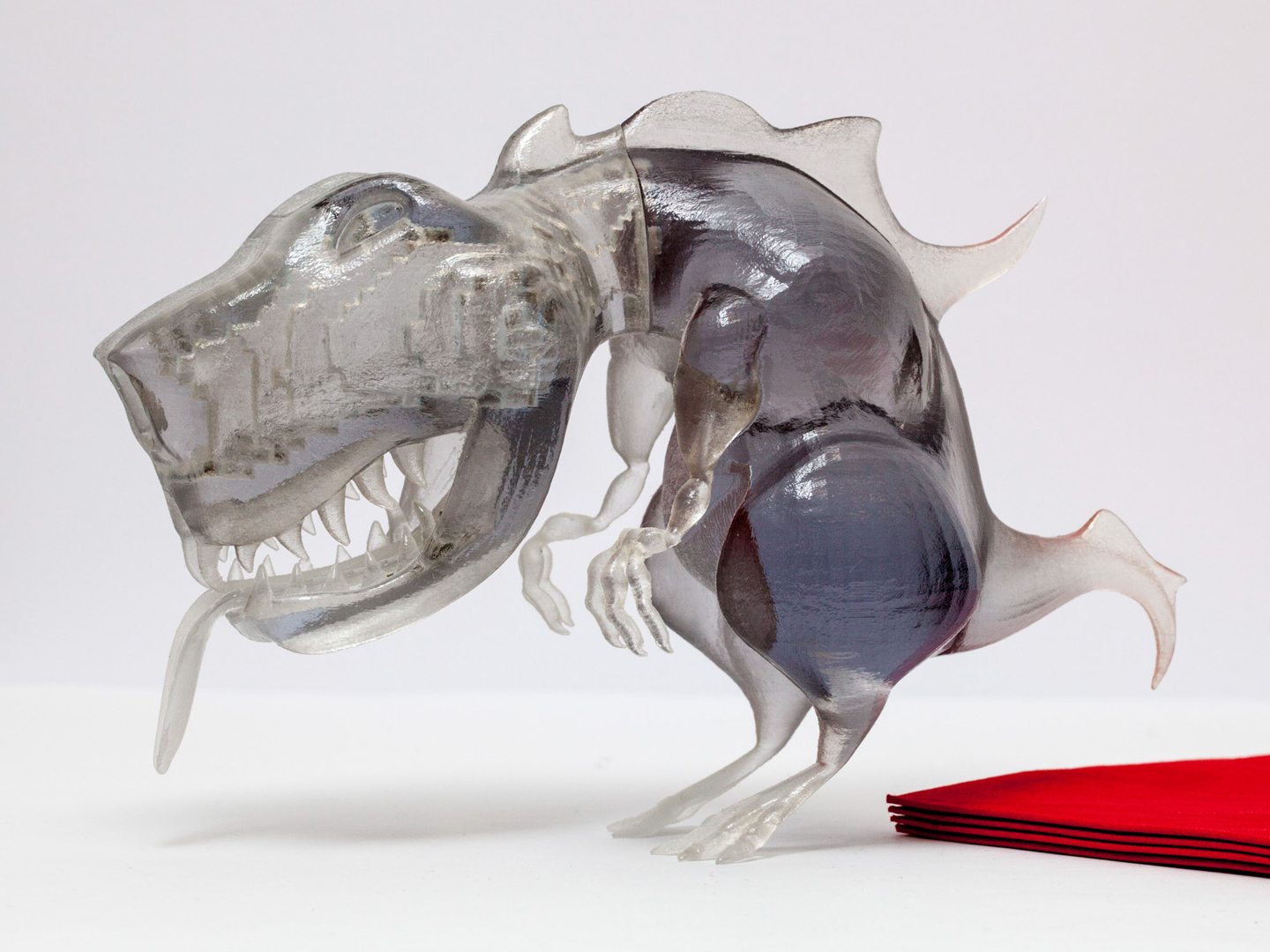“Make it stand: balancing shapes for 3D fabrication” by Prevost, Whiting, Lefebvre and Sorkine-Hornung
Conference:
Type(s):
Title:
- Make it stand: balancing shapes for 3D fabrication
Session/Category Title: Design & Authoring
Presenter(s)/Author(s):
Moderator(s):
Abstract:
Imbalance suggests a feeling of dynamism and movement in static objects. It is therefore not surprising that many 3D models stand in impossibly balanced configurations. As long as the models remain in a computer this is of no consequence: the laws of physics do not apply. However, fabrication through 3D printing breaks the illusion: printed models topple instead of standing as initially intended. We propose to assist users in producing novel, properly balanced designs by interactively deforming an existing model. We formulate balance optimization as an energy minimization, improving stability by modifying the volume of the object, while preserving its surface details. This takes place during interactive editing: the user cooperates with our optimizer towards the end result. We demonstrate our method on a variety of models. With our technique, users can produce fabricated objects that stand in one or more surprising poses without requiring glue or heavy pedestals.
References:
1. Allaire, G. 2001. Shape optimization by the homogenization method, vol. 146 of Applied Mathematical Sciences. Springer.Google Scholar
2. Bächer, M., Bickel, B., James, D. L., and Pfister, H. 2012. Fabricating articulated characters from skinned meshes. ACM Trans. Graph. 31, 4. Google ScholarDigital Library
3. Botsch, M., and Sorkine, O. 2008. On linear variational surface deformation methods. IEEE Trans. Vis. Comput. Graph. 14, 1, 213–230. Google ScholarDigital Library
4. Calì, J., Calian, D. A., Amati, C., Kleinberger, R., Steed, A., Kautz, J., and Weyrich, T. 2012. 3D-printing of non-assembly, articulated models. ACM Trans. Graph. 31, 6, 130:1–130:8. Google ScholarDigital Library
5. Derouet-Jourdan, A., Bertails-Descoubes, F., and Thollot, J. 2010. Stable inverse dynamic curves. ACM Trans. Graph., 137:1–137:10. Google ScholarDigital Library
6. Harmon, D., Panozzo, D., Sorkine, O., and Zorin, D. 2011. Interference aware geometric modeling. ACM Trans. Graph. 30, 6, 137:1–137:10. Google ScholarDigital Library
7. Jacobson, A., Baran, I., Popović, J., and Sorkine, O. 2011. Bounded biharmonic weights for real-time deformation. ACM Trans. Graph. 30, 4, 78:1–78:8. Google ScholarDigital Library
8. Jacobson, A., Baran, I., Kavan, L., Popović, J., and Sorkine, O. 2012. Fast automatic skinning transformations. ACM Trans. Graph. 30, 4, 77:1–77:10. Google ScholarDigital Library
9. Kedziora, J., 2011. Balancing sculptures. Display at the Kinetica Art Fair.Google Scholar
10. Lauer, D. A., and Pentak, S. 2011. Design Basics. Wadsworth Publishing.Google Scholar
11. Luo, L., Baran, I., Rusinkiewicz, S., and Matusik, W. 2012. Chopper: Partitioning models into 3D-printable parts. ACM Trans. Graph. 31, 6. Google ScholarDigital Library
12. Ortega, J., and Rheinboldt, W. 1970. Iterative solution of nonlinear equations in several variables. Academic Press.Google Scholar
13. Rivers, A., Adams, A., and Durand, F. 2012. Sculpting by numbers. ACM Trans. Graph. 31, 6, 157:1–157:7. Google ScholarDigital Library
14. Rivers, A., Moyer, I. E., and Durand, F. 2012. Position-correcting tools for 2D digital fabrication. ACM Trans. Graph. 31, 4, 88:1–88:7. Google ScholarDigital Library
15. Saul, G., Lau, M., Mitani, J., and Igarashi, T. 2011. Sketchchair: an all-in-one chair design system for end users. In Proc. 5th Intl. Conf. Tangible, Embedded, and Embodied Interaction, 73–80. Google ScholarDigital Library
16. Schneider, P. J., and Eberly, D. H. 2002. Geometric Tools for Computer Graphics. Morgan Kaufmann Publishers. Google ScholarDigital Library
17. Sheffer, A., and Hart, J. C. 2002. Seamster: inconspicuous low-distortion texture seam layout. In Proc. Visualization, IEEE Computer Society, 291–298. Google ScholarDigital Library
18. Shi, X., Zhou, K., Tong, Y., Desbrun, M., Bao, H., and Guo, B. 2007. Mesh puppetry: cascading optimization of mesh deformation with inverse kinematics. ACM Trans. Graph. 26, 3. Google ScholarDigital Library
19. Smithson, R., 1968. Gyrostasis. Permanent collection of the Hirshhorn Museum.Google Scholar
20. Sorkine, O., Lipman, Y., Cohen-Or, D., Alexa, M., Rössl, C., and Seidel, H.-P. 2004. Laplacian surface editing. In Proc. Symposium on Geometry Processing, 179–188. Google ScholarDigital Library
21. Stava, O., Vanek, J., Benes, B., Carr, N. A., and Mech, R. 2012. Stress relief: improving structural strength of 3D printable objects. ACM Trans. Graph. 31, 4, 48. Google ScholarDigital Library
22. Telea, A., and Jalba, A. 2011. Voxel-based assessment of printability of 3D shapes. In Proc. ISMM, 393–404. Google ScholarDigital Library
23. Umetani, N., Igarashi, T., and Mitra, N. J. 2012. Guided exploration of physically valid shapes for furniture design. ACM Trans. Graph. 31, 4. Google ScholarDigital Library
24. von Meiss, P. 1990. Elements of architecture: from form to place. Routledge.Google Scholar
25. Vouga, E., Höbinger, M., Wallner, J., and Pottmann, H. 2012. Design of self-supporting surfaces. ACM Trans. Graph. 31, 4, 87:1–87:11. Google ScholarDigital Library
26. Whiting, E., Ochsendorf, J., and Durand, F. 2009. Procedural modeling of structurally-sound masonry buildings. ACM Trans. Graph. 28, 5, 112:1–112:9. Google ScholarDigital Library
27. Whiting, E., Shin, H., Wang, R., Ochsendorf, J., and Durand, F. 2012. Structural optimization of 3D masonry buildings. ACM Trans. Graph. 31, 6, 159:1–159:11. Google ScholarDigital Library
28. Zhu, L., Xu, W., Snyder, J., Liu, Y., Wang, G., and Guo, B. 2012. Motion-guided mechanical toy modeling. ACM Trans. Graph. 31, 6, 127:1–127:10. Google ScholarDigital Library




